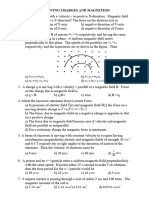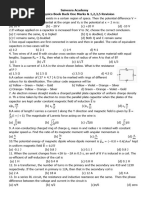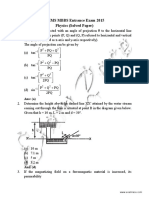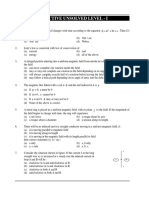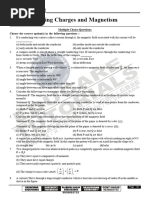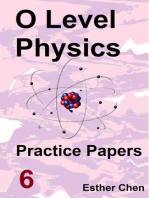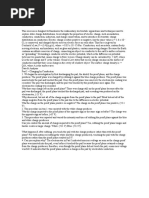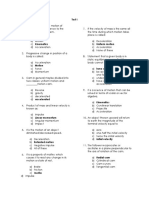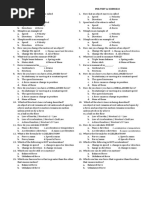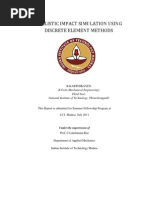GHCTHMXR
GHCTHMXR
Uploaded by
Shrey GeethanCopyright:
Available Formats
GHCTHMXR
GHCTHMXR
Uploaded by
Shrey GeethanOriginal Description:
Original Title
Copyright
Available Formats
Share this document
Did you find this document useful?
Is this content inappropriate?
Copyright:
Available Formats
GHCTHMXR
GHCTHMXR
Uploaded by
Shrey GeethanCopyright:
Available Formats
Downloaded from www.studiestoday.
com
OBJECTIVES
1. Two circular coils P and Q are made from similar wires but radius of Q is twice that of P. What should
be the value of potential difference across them so that the magnetic induction at their centre may be
the same?
(a) Vq = 2 Vp (b) Vq = 3VP (c) Vq = 4Vp (d) Vq = 1/4 Vp
2. The radius of the circular path or helical path followed by the test change q0 moving in magnetic field
B with velocity v is
m v sin θ m v cos θ mv m v tan θ
(a) q0 B (b) q0 B (c) q B (d) q0 B
om
0
3. An electron accelerated through a potential difference V enters into a uniform transverse magnetic
field and experiences a force F. If the accelerating potential is increased to 2 V, the electron in the
.c
same magnetic field will experience a force :
ay
(a) F (b) F/2 (c) 2F (d) 2F
4. A charged particle moving in a uniform magnetic field penetrates a layer of lead and loses one half of
od
its kinetic energy. The ratio of radius of curvature to the original radius is
1 1
(a) 2 (b) 2 (c) (d)
2 2
t
es
5. Two straight long conductors AOB and COD are perpendicular to each other and carry currents i1 and
i2. The magnitude of the magnetic induction at a point P at a distance d from the point O in a direction
di
perpendicular to the plane ABCD is
μ0 μ0
(a) 2π d (i1 + i2 ) (b) 4π d (i1 − i2 )
tu
μ 0 2 2 1/2 μ0 i1i2
.s
(c) (i + i ) (d) 2π d
2π d 1 2 i1 + i2
w
6. A current of 10 amp. is flowing in a wire of length 1.5 metre. A force of 15 newton acts on it when it
w
is placed in a uniform magnetic field of 2 tesla. The angle between the magnetic field and the direction
of current is
w
(a) 30º (b) 45º (c) 60º (d) 90º
7. A particle carrying a charge equal to 100 times the charge on an electron is rotating per second in a
circular path of radius 0.8 m. The value of the magnetic field produced at the centre will be (μ0 =
permeability constant).
(a) 10–7/μ0 (b) 10–17 μ0 (c) 10–6 / μ0 C (d) 10–7 μ0
8. The magnetic field at the centre O of the circular portion of
4Amp. O
the current carrying wire of radius 3 cm is
π/2
(a) (8π/3) × 10–5 T (b) (8π/3) × 10–4 T
B D
(c) 2π × 10 T–5
(d) 2π × 10–4 T
A E
Downloaded from www.studiestoday.com
Downloaded from www.studiestoday.com
9. A long wire carries a current of 20 A along the axis of a solenoid. The field due to the solenoid is 4 mT.
the resultant field at a point 3 mm from the solenoid axis is
(a) 1.33 m T (b) 4.2 mT (c) 2.1 m T (d) 8.4 m T
10. A circular current carrying coil has a radius R. The distance from the centre of the coil on the axis
where the magnetic induction will be (1/8)th of its value at the centre of the coil is
(a) R 3 (b) 2 R 3 (c) R / 3 (d) 2 R / 3
11. A proton moving with a constant velocity passes through a region of space without any change in its
velocity. If E and B represent the electric and magnetic fields respectively, identify wrong statement
(a) E = 0, B = 0 (b) E = 0, B ≠ 0 (c) E ≠ 0, B = 0 (d) E ≠ 0, B≠ 0
12. An electron is moving in a circle of radius r in a uniform magnetic field B. Suddenly the field is reduced
om
to B/2. The radius of the circle now becomes
(a) r/2 (b) r/4 (c) 2 r (d) 4 r
.c
13. A proton and an α-particle, moving with the same kinetic energy, enters a uniform magnetic field
normally. The radii of their circular paths will be in the ratio
14.
(a) 1 : 1 (b) 2 : 1
ay (c) 1 : 2 (d) 4 : 1
A beam of electrons is accelerated through a potential difference V. It is then passed normally through
od
a uniform magnetic field where it moves in a circle of radius r. It would have moved in a circle of
radius 2r if it were initially accelerated through a potential difference
t
es
(a) 2V (b) 2V (c) 2 2 V (d) 4V
15. A proton and an α-particle, accelerated through the same potential difference, enter a region of uniform
di
magnetic field normally. If the radius of the proton orbit is 10 cm then the radius of of the α-orbit is
tu
(a) 10 cm (b) 10 2 cm (c) 20 cm (d) 5 2 cm
.s
16. Two particles X and Y having equal charge, after being accelerated through the same potential difference,
enter a region of uniform magnetic field and describe circular paths of radii R1 and R2 respectively.
w
The ratio of the mass of X to that of Y is
w
(a) (R1 / R2)1/2 (b) R2 / R1 (c) (R1 / R2)2 (d) R1 / R2
w
17. A particle of charge +q and mass m moving under the influence of a uniform electric field Ei and a
uniform magnetic field B k follows a trajectory from P to Q as shown in the figure. The velocities at
P and Q are v i and –2v j. Which of the following statements is incorrect
m v2 E
3
(a) E = y v
4 qa P B
3 m v 3
(b) Rate of work done by the electric field at P is
4 a
Q
x
(c) Rate of work done by the electric field at P is zero 2a 2v
(d) Rate of work done by both the fields at Q is zero
Downloaded from www.studiestoday.com
Downloaded from www.studiestoday.com
18. A horizontal wire of length 10 cm and mass 0.3 g carries a current of 5 A. The magnitude of the
magnetic field which can support the weight of the wire is (g = 10 m/s2)
(a) 3 × 10–3 T (b) 6 × 10–3 T (c) 3 × 10–4 T (d) 6 × 10–4 T
19. A 2 MeV proton (mass = 1.6 × 10–27 kg) is moving perpendicular to a uniform magnetic field of 2.5 T.
The magnetic force on the proton is
(a) 2.5 × 10–10 N (b) 8 × 10–11 N (c) 2.5 × 10–11 N (d) 8 × 10–12 N
20. A portion of a long straight wire, carrying a current I, is bent in the form of a semicircle of radius r as
shown in the figure. The magnetic field at the centre O of the semicircle, in tesla, is
om
r
I
πI
.c
πI −7 πI πI
(a) ×10 (b) (c) × 107 (d)
r r r 2r
21.
ay
A long straight conductor, carrying a current I, is bent into
the shape shown in the figure. The radius of the circular
od
loop is r. The magnetic field at the centre of the loop is r
μ0 I 1 μ0 I 1
t
I
1+ 1−
(a) 2r π into the page (b) 2r π out of the page
es
μ0 I 1 μ0 I 1
1− 1+
2r π into the page (d) 2r π out of the page
di
(c)
tu
22. A rectangular loop carrying a current i is situated near a long straight wire such that the wire is parallel
to one of the sides of the loop and is in the plane of the loop. If a steady current I is established in the
.s
wire as shown in the figure, the loop will
i
w
(a) rotate about an axis parallel to the wire
(b) move away from the wire
w
I
(c) move towards the wire
w
(d) remain stationary
23. A square coil of side a carries a current I. The magnetic field at the centre of the coil is
a I O
μ0 I 2 μ0 I μ0 I 2 2 μ0 I
(a) (b) aπ (c) 2 aπ (d) aπ
aπ
Downloaded from www.studiestoday.com
Downloaded from www.studiestoday.com
24. A circular current -carrying coil has a radius R. The distance from the centre of the coil, on the axis,
where B will be 1/8th of its value at the centre of the coil is
2R
(a) R / 3 (b) 3R (c) 2 3 R (d)
3
25. In a figure AB is a long straight wire carrying a current of 20 A and CDFG is a rectangular loop of size
20 cm × 9 cm carrying a current of 10 A. The edge CG is parallel to AB, at a distance of 1 cm from
it. The force exerted on the loop by the magnetic field of the wire is
B C D
1cm
9cm
om
20A 10A 20cm
.c
A G F
(a) 3.6 × 10–4 N towards left
(c) 7.2 × 10–4 N towards right ay (b) 3.6 × 10–4 N towards right
(d) 7.2 × 10–4 N towards left
od
26. In the figure x, y and z are long straight wires. The magnetic force on 25 cm length of y is
t
(a) 2 × 10–4 N towards right (b) 4 × 10–4 N towards right
es
(c) 2 × 10–4 N towards left (d) 4 × 10–4 N towards left
x y z
di
tu
30A
10A 20A
.s
3cm 10cm
w
w
27. A current of I ampere flows in a wire forming a circular arc of radius r metres subtending an angle θ
w
at the centre as shown. The magnetic field at the centre O in tesla is
μ 0 Iθ μ 0 Iθ μ 0 Iθ μ 0 Iθ
(a) (b) (c) (d)
4πr 2πr 2r 4r
Downloaded from www.studiestoday.com
Downloaded from www.studiestoday.com
28. In the given loop, the magnetic field at the centre O is
I O r2
r1
μ0 I r1 + r2 μ0 I r1 + r2
(a) out of the page (b) into the page
4 r1r2 4 r1r2
μ0 I r1 − r2 μ0 I r1 − r2
(c) out of the page (d) out of the page
4 r1r2 2 r1 r2
29. A proton and an α-particle enter a uniform magnetic field perpendicularly, with the same speed. If the
om
proton takes 25 microseconds to make 5 revolutions, the periodic time for the α-particle would be
(a) 50 μs (b) 25 μs (c) 10 μs (d) 5 μs
.c
30. A proton, a deuteron and an α-particle, having the same kinetic energy, are moving in circular trajectories
in a constant magnetic field. If rp, rd and rα denote, respectively, the radii of the trajectories of these
particles, then
(a) rα = rp < rd (b) rα > rd > rp ay (c) rα = rd > rp (d) rp = rd < rα
t od
es
di
ANSWERS
tu
.s
Objectives
w
1. (c) 2. (a) 3. (c) 4. (d) 5. (c)
w
6. (a) 7. (b) 8. (c) 9. (b) 10. (a)
w
11. (c) 12. (c) 13. (a) 14. (d) 15. (b)
16. (c) 17. (c) 18. (b) 19. (d) 20. (a)
21. (c) 22. (c) 23. (d) 24. (b) 25. (d)
26. (b) 27. (a) 28. (b) 29. (c) 30. (a)
Downloaded from www.studiestoday.com
You might also like
- MAAPReviewerDocument66 pagesMAAPReviewerJamelle67% (3)
- Unit Test 5: (Magnetostatics EMI and AC, EM Waves)Document5 pagesUnit Test 5: (Magnetostatics EMI and AC, EM Waves)padhi8480No ratings yet
- Mec dpp-5Document2 pagesMec dpp-5dushyantsingh44787No ratings yet
- Moving Charges and Magnetism -MCQDocument5 pagesMoving Charges and Magnetism -MCQvarnikadalal05No ratings yet
- 21c0c9cc-718e-4d4b-9faa-33a6d8df333a-1711806963151-4102608560960521Document10 pages21c0c9cc-718e-4d4b-9faa-33a6d8df333a-1711806963151-4102608560960521Samara KhanNo ratings yet
- Moving Charges and MagnetismDocument10 pagesMoving Charges and Magnetismrahulsoorya2001No ratings yet
- Physics and Chemistry: AIEEE - 2002Document18 pagesPhysics and Chemistry: AIEEE - 2002BikramNo ratings yet
- Chapter 4,5 MCQDocument2 pagesChapter 4,5 MCQHarishankar SNo ratings yet
- (WWW - Entrance-Exam - Net) - AIEEE Maths Sample Paper 7Document20 pages(WWW - Entrance-Exam - Net) - AIEEE Maths Sample Paper 7Aditya RamNo ratings yet
- COMMEDIA Phy ObjectiveTest1QP 20241202160426 1Document5 pagesCOMMEDIA Phy ObjectiveTest1QP 20241202160426 1egamscdm9No ratings yet
- Aieee 2003Document20 pagesAieee 2003gunjan kadelNo ratings yet
- selfstudys_com_file (49)Document38 pagesselfstudys_com_file (49)MahenderSinghNo ratings yet
- AIEEE 2003 Questions PapersDocument20 pagesAIEEE 2003 Questions PapersAditya RamNo ratings yet
- Neet 2007 PypDocument34 pagesNeet 2007 PypAdarsh MusixNo ratings yet
- AIEEE2003Document45 pagesAIEEE2003alabasmNo ratings yet
- AIEEE 2002 Question PaperDocument18 pagesAIEEE 2002 Question PaperHimkar SinghNo ratings yet
- 50Q - Electromagnetic InductionDocument10 pages50Q - Electromagnetic InductionshobhasunilsinghNo ratings yet
- Moving Charges and MagnetismDocument12 pagesMoving Charges and Magnetismbhaniahuja11No ratings yet
- Met question paperDocument31 pagesMet question paperShah VeNo ratings yet
- MOVING CHARGE – MAGNETISM – MATTERDocument8 pagesMOVING CHARGE – MAGNETISM – MATTERastitvapandey980No ratings yet
- Physics Set 1 2022-23 BoardDocument11 pagesPhysics Set 1 2022-23 BoardKennedy Oswald AikaruwaNo ratings yet
- AIEEE 2002 Question PaperDocument18 pagesAIEEE 2002 Question PaperAditya RamNo ratings yet
- PYQ MagnetismDocument12 pagesPYQ Magnetismkahehox418No ratings yet
- 4 - Moving Charges & MagnetismDocument15 pages4 - Moving Charges & MagnetismAawesh BackupsNo ratings yet
- Electrostatics DPPDocument5 pagesElectrostatics DPPankitteddy94No ratings yet
- Moving charge 51Document16 pagesMoving charge 51shreyanshkumar5210No ratings yet
- Physics XII CH 4 MCQ Moving Charges and MagnetismDocument12 pagesPhysics XII CH 4 MCQ Moving Charges and MagnetismM S100% (1)
- One Mark Answer KeyDocument4 pagesOne Mark Answer Keyeniya948No ratings yet
- AIEEE 2003 Questions Papers PDFDocument20 pagesAIEEE 2003 Questions Papers PDFRemoNo ratings yet
- Practice Questions 3Document2 pagesPractice Questions 3vinothblood3No ratings yet
- Physics -SET 1Document8 pagesPhysics -SET 1jpal61491No ratings yet
- Otqs Moving Charges and MagnetismDocument9 pagesOtqs Moving Charges and MagnetismHemanth KNo ratings yet
- 2021 - Question - Paper BitsatDocument15 pages2021 - Question - Paper BitsatNitisha GuptaNo ratings yet
- 12th Physics Book Back One Marks & 1,2,3,5 RevisionDocument4 pages12th Physics Book Back One Marks & 1,2,3,5 Revisionroshanvinayak79No ratings yet
- CH 4Document10 pagesCH 4thyadiadarshNo ratings yet
- M1 TestDocument3 pagesM1 Testsehajpahwa0009No ratings yet
- MT 1 Phy Mock eDocument9 pagesMT 1 Phy Mock eChetnaNo ratings yet
- QBank - Electromagnetic InductionDocument10 pagesQBank - Electromagnetic InductionMoon KnightNo ratings yet
- 8 Copies 3rd Sem 2k19Document7 pages8 Copies 3rd Sem 2k19Abin VargheseNo ratings yet
- 12 Phy Part2 Test With AnswersDocument12 pages12 Phy Part2 Test With AnswersChirag SNo ratings yet
- DCT19_MEEC_(Set A)Document8 pagesDCT19_MEEC_(Set A)Prakash JaisNo ratings yet
- CH 4. MCQ Ar Case BasedDocument8 pagesCH 4. MCQ Ar Case Basedsaikishorea.bNo ratings yet
- Gate 2003 PHDocument12 pagesGate 2003 PHPasupuleti AnilNo ratings yet
- MCQ SAMPLE PAPER PHYSICS 1Document5 pagesMCQ SAMPLE PAPER PHYSICS 1rajpvtt2No ratings yet
- Aieee 2002Document32 pagesAieee 2002Mohit YadavNo ratings yet
- BITSAT 2021 Question Paper (Memory-Based)Document13 pagesBITSAT 2021 Question Paper (Memory-Based)rirov78741No ratings yet
- 2021 P For Kjrrent - Magnetism - Chapter - TestDocument6 pages2021 P For Kjrrent - Magnetism - Chapter - TestRSNo ratings yet
- Qp Physics 12 Common Exam Set 1 (1)Document6 pagesQp Physics 12 Common Exam Set 1 (1)riicasticNo ratings yet
- AIIMS Solved Paper 2015Document64 pagesAIIMS Solved Paper 2015pinky sisodiya0% (1)
- ELECTROMAGNETIC INDUCTION-04-Objective UnSolvedDocument7 pagesELECTROMAGNETIC INDUCTION-04-Objective UnSolvedRaju SinghNo ratings yet
- Ts Eamcet: Question Paper 2017Document39 pagesTs Eamcet: Question Paper 2017songa akashNo ratings yet
- MCQs Moving Charge and MagnetismDocument9 pagesMCQs Moving Charge and MagnetismnilusclassesNo ratings yet
- paper 1 set 2Document12 pagespaper 1 set 2mankeshav7No ratings yet
- CBSE Class 12 Physics Sample Paper Set 3 With Solutions (2024-25) PDFDocument40 pagesCBSE Class 12 Physics Sample Paper Set 3 With Solutions (2024-25) PDFalightmotionaanuNo ratings yet
- Moving Charges and MagnetismDocument10 pagesMoving Charges and Magnetismmohitbhatt1975No ratings yet
- Aissce Asgnmt CH - 04Document5 pagesAissce Asgnmt CH - 04Arunima SinghNo ratings yet
- Electron Beam-Specimen Interactions and Simulation Methods in MicroscopyFrom EverandElectron Beam-Specimen Interactions and Simulation Methods in MicroscopyNo ratings yet
- Vacuum Nanoelectronic Devices: Novel Electron Sources and ApplicationsFrom EverandVacuum Nanoelectronic Devices: Novel Electron Sources and ApplicationsNo ratings yet
- 6 - Velocity PolygonDocument13 pages6 - Velocity PolygonGuillermo Fernandez RodriguezNo ratings yet
- 07 Handout 1basics of Motion 1Document9 pages07 Handout 1basics of Motion 1Gideon AriasNo ratings yet
- Physics 30 Worksheet # 1: MomentumDocument18 pagesPhysics 30 Worksheet # 1: Momentumrchop350% (2)
- Air TableDocument23 pagesAir Tablehelin karatepeNo ratings yet
- Cets Reviewer Ak - General ScienceDocument15 pagesCets Reviewer Ak - General ScienceJatskinesisNo ratings yet
- Kinematics P ME KNM 10-11-12Document3 pagesKinematics P ME KNM 10-11-12Raghav MishraNo ratings yet
- Physics Sample DPQDocument2 pagesPhysics Sample DPQhardworking_studentNo ratings yet
- WWW - Ib.academy: Study GuideDocument95 pagesWWW - Ib.academy: Study GuideGag PafNo ratings yet
- Velocity and AccelerationDocument5 pagesVelocity and AccelerationNukris HakimiNo ratings yet
- Ae262 20222 Section1 hw1Document3 pagesAe262 20222 Section1 hw1Kaan ANo ratings yet
- Experiment E1Document3 pagesExperiment E1Zack ParkNo ratings yet
- PHY13 Lesson 1 MagnetismDocument48 pagesPHY13 Lesson 1 MagnetismAmante Rivera JrNo ratings yet
- Chapter 13 ModifiedDocument5 pagesChapter 13 Modifiedapi-248642018100% (1)
- Practice ProblemsDocument4 pagesPractice ProblemsDallinNo ratings yet
- Solutions of 5 Online Physics BrawlDocument45 pagesSolutions of 5 Online Physics BrawlKetul ShahNo ratings yet
- Question 1Document12 pagesQuestion 1eka123No ratings yet
- Developing Agility and Quickness (Etc.) (Z-Library) - 80Document2 pagesDeveloping Agility and Quickness (Etc.) (Z-Library) - 80guypetro6No ratings yet
- Exercises For KinematicsDocument2 pagesExercises For KinematicsMaria Laksmi SarestriNo ratings yet
- Problem Set 2Document3 pagesProblem Set 2timothy dengNo ratings yet
- Mechanic Lab SheetDocument81 pagesMechanic Lab SheetYanie DianeeNo ratings yet
- Calculus 3 Test 1 UHDocument6 pagesCalculus 3 Test 1 UHEliezerNo ratings yet
- Duaso ElementsDocument202 pagesDuaso ElementsAnonymous hndZWISrhYNo ratings yet
- 11th Physics Government Question Paper Five MarksDocument8 pages11th Physics Government Question Paper Five Markskaviyajack872No ratings yet
- Circular Motion, 2D Motion, Mechanics Revision Notes From A-Level Maths TutorDocument6 pagesCircular Motion, 2D Motion, Mechanics Revision Notes From A-Level Maths TutorA-level Maths Tutor100% (2)
- Pretest G8Document1 pagePretest G8trexia autidaNo ratings yet
- UntitledDocument15 pagesUntitledMessias Martins - JUBANo ratings yet
- Lecture 4 - Section 12.5 - Hibbeler 15th Ed - (Blank)Document14 pagesLecture 4 - Section 12.5 - Hibbeler 15th Ed - (Blank)babsthemanateeNo ratings yet
- 2._NEET_NKC_Kinematics_11_pg_.pdfDocument26 pages2._NEET_NKC_Kinematics_11_pg_.pdfDeepak PathakNo ratings yet
- Ballistic Impact Simulation Using DEMDocument24 pagesBallistic Impact Simulation Using DEMKarthikayen RajuNo ratings yet





